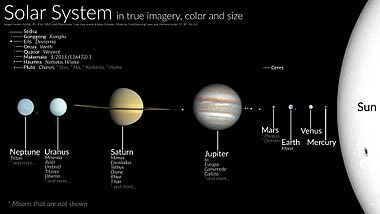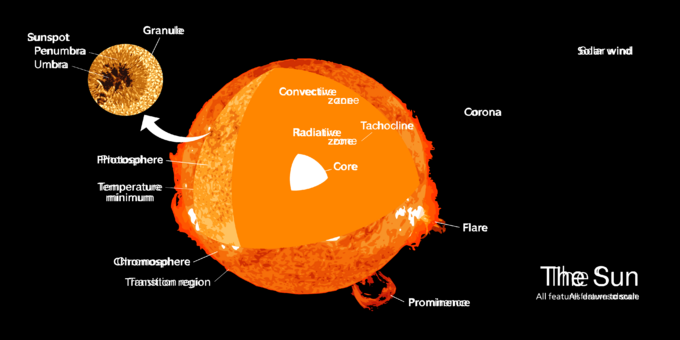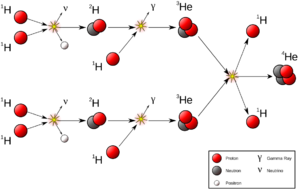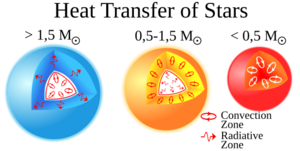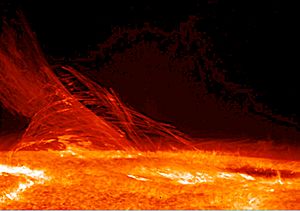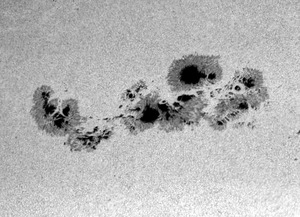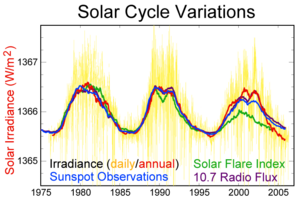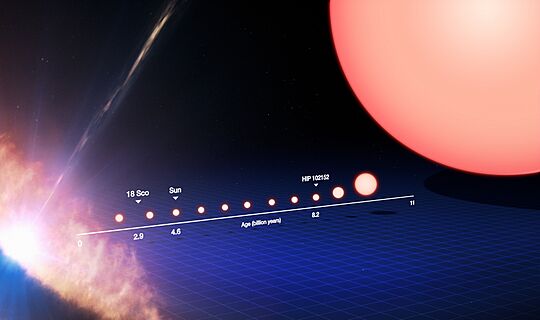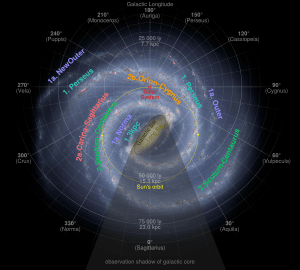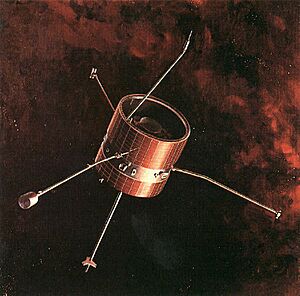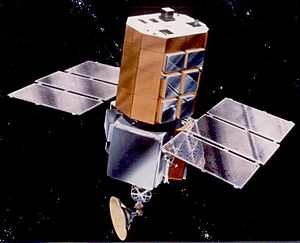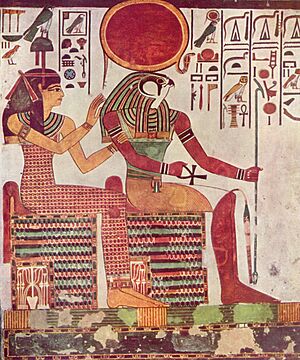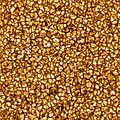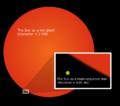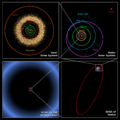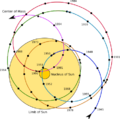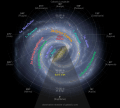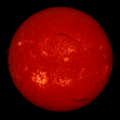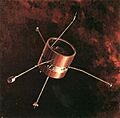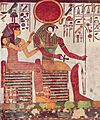Sun facts for kids
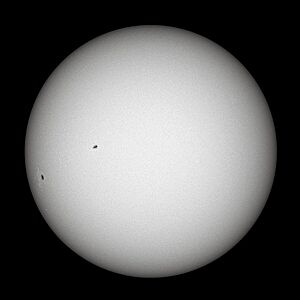
The Sun, viewed through a clear solar filter
|
|
| Names | Sun, Sol, Sól, Helios |
|---|---|
| Adjectives | Solar |
| Symbol | |
| Observation data | |
| Mean distance from Earth | 1 AU 149,600,000 km 8 min 19 s, light speed |
| −26.74 (V) | |
| 4.83 | |
| G2V | |
| Metallicity | Z = 0.0122 |
| Angular size | 0.527–0.545° |
| Orbital characteristics | |
|
Mean distance from Milky Way core
|
24,000 to 28,000 light-years |
| Galactic period | 225–250 million years |
| Velocity |
|
| Obliquity |
|
|
Right ascension North pole
|
286.13° (286° 7′ 48″) |
|
Declination of North pole
|
+63.87° (63° 52′ 12"N) |
|
Sidereal rotation period
|
|
|
Equatorial rotation velocity
|
1.997 km/s |
| Physical characteristics | |
|
Equatorial radius
|
695,700 km 109 × Earth radii |
| Flattening | 0.00005 |
| Surface area | 6.09×1012 km2 12,000 × Earth |
| Volume |
|
| Mass |
|
| Average density | 1.408 g/cm3 0.255 × Earth |
| Age | 4.6 billion years |
|
Equatorial surface gravity
|
274 m/s2 27.9 g0 |
|
Moment of inertia factor
|
≈0.070 |
|
Surface escape velocity
|
617.7 km/s 55 × Earth |
| Temperature |
|
| Luminosity | |
| Colour (B-V) | 0.656 |
| Mean radiance | 2.009×107 W·m−2·sr−1 |
|
Photosphere composition by mass
|
|
The Sun is the star at the center of our Solar System. It is a huge, almost perfect ball of super hot gas called plasma. The Sun glows brightly because of nuclear fusion reactions happening deep inside it. This process creates energy that travels from the Sun's surface mostly as visible light and infrared radiation. About 10% of its energy is ultraviolet light.
The Sun is the most important source of energy for all life on Earth. Many cultures throughout history have seen the Sun as a special or even sacred object. Scientists have studied the Sun for thousands of years.
The Sun is about 149.6 million kilometers (93 million miles) from Earth. This distance is called an astronomical unit (AU). Light from the Sun takes about 8 minutes and 19 seconds to reach us. The Sun is about 109 times wider than Earth. Its mass is about 330,000 times that of Earth. This means the Sun makes up about 99.86% of all the mass in the Solar System! The Sun's outer layer, called the photosphere, is mostly hydrogen (about 73%) and helium (about 25%). It also has small amounts of heavier elements like oxygen and iron.
The Sun is a G-type main-sequence star, which scientists sometimes call a "yellow dwarf." But its light is actually white. It formed about 4.6 billion years ago. This happened when a giant cloud of gas and dust collapsed due to gravity. Most of this material gathered in the middle, forming the Sun. The rest flattened into a spinning disk, which became the planets and other parts of our Solar System. The center of the Sun became so hot and dense that nuclear fusion began. Every second, the Sun's core turns about 600 billion kilograms of hydrogen into helium. It also changes 4 billion kilograms of matter into energy.
In about 4 to 7 billion years, the Sun will start to run out of hydrogen fuel in its core. When this happens, its core will get much hotter and denser. The outer layers of the Sun will then expand greatly. The Sun will turn into a red giant star. After this red giant phase, the Sun will shed its outer layers. It will then become a small, dense, cooling star called a white dwarf. It will no longer make energy through fusion. However, it will still glow and give off heat for trillions of years. Scientists believe it will eventually become a super dense black dwarf, giving off almost no energy.
Contents
What is the Sun?
The Sun is a G-type main-sequence star. It holds almost all the mass in our Solar System, about 99.86% of it. The Sun is brighter than about 85% of the stars in the Milky Way galaxy. Most other stars are smaller and dimmer red dwarfs.
The Sun is a "Population I" star. This means it has many heavy elements. It formed about 4.6 billion years ago. Scientists think its formation might have been started by shockwaves from nearby exploding stars called supernovae. This idea comes from the large amount of heavy elements like gold and uranium found in our Solar System. These elements are usually made during supernova explosions.
The Sun is the brightest object we see in Earth's sky. It is about 13 billion times brighter than the next brightest star, Sirius.
The average distance between the Sun and Earth is called an astronomical unit (AU). This distance is about 149.6 million kilometers. Earth's distance from the Sun changes slightly throughout the year. It is closest in January and farthest in July. Sunlight provides almost all the energy for life on Earth through photosynthesis. It also controls Earth's weather and climate.
The Sun does not have a solid surface. Its density gets lower and lower as you move away from its center. Scientists define the Sun's radius as the distance from its center to the edge of its visible surface, called the photosphere.
The Sun is almost a perfect sphere. Its shape is very slightly flattened at the poles. This flattening is so small that the Sun is considered the most perfectly round natural object ever observed.
How Does the Sun Spin?
The Sun spins faster at its middle (equator) than at its top and bottom (poles). This is called differential rotation. It happens because of how heat moves inside the Sun and the Sun's own spin. The equator spins around in about 25.6 days. The poles take about 33.5 days to spin. From Earth, the Sun's equator seems to spin in about 28 days. If you looked down on the Sun from above its north pole, it would spin counter-clockwise.
Scientists believe the early Sun spun much faster, perhaps ten times faster than it does today. This would have made its surface much more active. Its spin slowed down over time because of its magnetic field interacting with the solar wind. The very center of the Sun still spins faster, completing a rotation about once a week.
What is the Sun Made Of?
The Sun is mostly made of hydrogen and helium. These two elements make up about 74.9% and 23.8% of the Sun's mass in its outer visible layer. All other heavier elements, which astronomers call "metals," make up less than 2% of the Sun's mass. The most common of these are oxygen (about 1%), carbon (0.3%), neon (0.2%), and iron (0.2%).
The Sun's original ingredients came from the giant cloud of gas and dust it formed from. Most of the hydrogen and helium were created during the Big Bang. Heavier elements were made by older stars that exploded before the Sun formed.
As the Sun has aged, it has been turning hydrogen into helium in its core. This means the amount of helium in the core has grown from about 24% to 60%. Some of the helium and heavier elements have slowly moved towards the Sun's center due to gravity. The outer layers of the Sun, like the photosphere, have less helium now.
In about 5 billion years, the Sun will run out of hydrogen in its core. This will cause it to leave its current "main sequence" stage and become a red giant.
How is the Sun Structured?
The Sun has several layers, like an onion.
The Sun's Core
The Sun's core is its very center. It goes out to about a quarter of the Sun's total radius. The core is incredibly dense, about 150 times denser than water. Its temperature is around 15.7 million kelvin (K). For comparison, the Sun's surface is about 5,800 K.
The core is the only place in the Sun where significant thermal energy is made through nuclear fusion. About 99% of the Sun's power comes from the innermost 24% of its radius. This energy then travels outward through many layers. It finally reaches the Sun's visible surface, the photosphere, where it escapes into space.
In the core, hydrogen atoms combine to form helium. This process releases a huge amount of energy. Every second, the Sun changes about 4.26 billion kilograms of matter into energy. This creates an enormous amount of power, about 384.6 yottawatts. Even though this sounds like a lot, the energy produced per cubic meter in the Sun's core is actually quite small. It's about the same as the heat made in a compost pile.
The rate of fusion in the core is naturally balanced. If fusion speeds up, the core heats up and expands slightly. This reduces the density and slows fusion down. If fusion slows down, the core cools and shrinks. This increases the density and speeds fusion up again. This keeps the Sun stable.
Radiative Zone
The radiative zone is the thickest layer of the Sun, outside the core. It extends from about 25% to 70% of the Sun's radius. In this layer, energy moves outward mainly through thermal radiation. This means tiny packets of light called photons carry the energy. The temperature drops from about 7 million K near the core to 2 million K at the top of this zone.
Photons are constantly absorbed and re-emitted by hydrogen and helium particles. This process is very slow. It can take a photon between 10,000 and 170,000 years to travel through the radiative zone to the Sun's surface!
Convective Zone
The Sun's convective zone is the layer above the radiative zone. It goes from about 70% of the Sun's radius to near its surface. In this layer, the gas is not dense enough for radiation to carry all the heat. Instead, hot gas rises, cools, and then sinks, like boiling water. This creates huge currents that carry heat to the Sun's surface.
When the gas reaches the surface, it cools and becomes denser. It then sinks back down to the bottom of the convective zone. There, it picks up more heat and rises again. This cycle keeps going. The surface of the Sun looks grainy because of these rising and sinking gas cells. This is called solar granulation.
The Sun's Atmosphere
The Sun's atmosphere is the region above the convective zone. It has three main layers: the photosphere, the chromosphere, and the corona. There's also a thin transition region between the chromosphere and corona.
Photosphere
The photosphere is the visible surface of the Sun. It's the layer where light can finally escape into space. This light is what we see as sunlight. The photosphere is hundreds of kilometers thick. It is slightly less dense than air on Earth.
The top of the photosphere is cooler than the bottom. This makes the Sun appear brighter in the center and darker towards its edges. This effect is called limb darkening. The photosphere has a temperature of about 5,772 K.
Chromosphere
Above the photosphere is the chromosphere. This layer is about 2,000 kilometers thick. It gets its name from the Greek word chroma, meaning color. It looks like a colored flash during a total solar eclipse. The temperature in the chromosphere increases with height, reaching about 20,000 K at its top.
Between the chromosphere and the corona is a thin transition region. Here, the temperature rises very quickly, from 20,000 K to about 1,000,000 K. This region is always moving and changing.
Corona
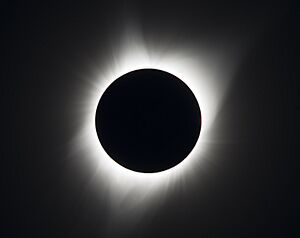
The corona is the Sun's outermost atmosphere. It is very hot, with temperatures between 1 million and 2 million K. In some areas, it can reach 8 million to 20 million K. Scientists are still trying to figure out why the corona is so much hotter than the Sun's surface. One idea is that energy from the Sun's magnetic field heats it.
The corona extends far out into space. It eventually turns into the solar wind. The Parker Solar Probe spacecraft has flown through the corona, getting closer to the Sun than any other spacecraft.
Heliosphere
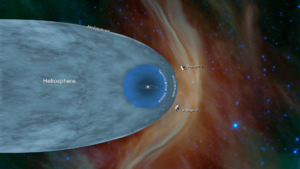
The heliosphere is a huge bubble of space around the Sun. In this region, the solar wind and the Sun's magnetic field are stronger than the forces from other stars. The solar wind flows outward through the heliosphere in a spiral shape. It reaches far beyond the planets, out to a boundary called the heliopause.
The Voyager 1 probe crossed the heliopause in 2012. It is now in interstellar space, which is the space between stars. The heliosphere has a "heliotail" that stretches out behind it. This is because the Sun is moving through the galaxy.
Solar Radiation
The Sun gives off light across the entire visible spectrum. When seen from space, or high in the sky, the Sun's true color is white. Its light appears yellow, orange, or red when it's low in the sky. This happens because Earth's atmosphere scatters blue light away.
The amount of power the Sun sends to Earth is called the solar constant. It's about 1,368 watts per square meter at Earth's orbit. On Earth's surface, the atmosphere blocks some of this energy. So, less power reaches us, around 1,000 watts per square meter on a clear day.
Sunlight is made up of about 50% infrared light, 40% visible light, and 10% ultraviolet light. Earth's atmosphere blocks over 70% of the Sun's ultraviolet (UV) light. UV light can kill germs and help our bodies make vitamin D. But too much UV light can cause sunburn and skin cancer. The ozone layer in Earth's atmosphere is very important for blocking harmful UV rays.
Energy from the Sun's core takes a very long time to reach the surface. Photons, which are light particles, are constantly absorbed and re-emitted. This journey can take tens of thousands of years. However, tiny particles called neutrinos, which are also made in the core, travel straight through the Sun and reach Earth in just 2.3 seconds.
Magnetic Activity
The Sun has a strong stellar magnetic field. This field changes across its surface and over time. The Sun's magnetic field is much weaker at its poles than in areas like sunspots. Sunspots can have magnetic fields thousands of times stronger than the poles.
The Sun's magnetic field extends far into space. The solar wind carries this magnetic field outward. This creates the interplanetary magnetic field, which spirals out from the Sun.
Sunspots
Sunspots look like dark patches on the Sun's surface. They are areas where strong magnetic fields stop heat from reaching the surface. Because they are cooler than the surrounding areas, they appear dark.
The number of sunspots changes in an 11-year cycle. At the lowest point of the cycle, there are very few sunspots. As the cycle moves towards its peak, more sunspots appear. They tend to form closer to the Sun's equator. The largest sunspots can be tens of thousands of kilometers wide.
The magnetic poles of sunspot pairs switch every 11-year cycle. This means the Sun's overall magnetic field flips its polarity every 22 years.
Solar Activity
The Sun's magnetic field causes many events called solar activity. These include solar flares and coronal mass ejections. Solar flares are sudden bursts of energy. Coronal mass ejections are huge bubbles of plasma and magnetic field that erupt from the Sun. Both send plasma and magnetic fields out into the Solar System.
Solar activity can affect Earth. It causes beautiful auroras (northern and southern lights). It can also disrupt radio communications and power grids. Scientists believe solar activity played a big role in how our Solar System formed.
Sometimes, the solar cycle can slow down or stop. For example, during the 17th century, there were very few sunspots for several decades. This period, called the Maunder minimum, happened at the same time as a "Little Ice Age" in Europe. This suggests a link between solar activity and Earth's climate.
Coronal Heating
The Sun's surface (photosphere) is about 6,000 K. But the corona, its outermost atmosphere, is much hotter, reaching 1 million to 2 million K. This is a big mystery for scientists. They think the energy to heat the corona comes from the turbulent motion in the convection zone below.
Two main ideas explain coronal heating. One is "wave heating," where waves from the Sun's interior travel up and release energy in the corona. The other is "magnetic heating," where the Sun's magnetic energy builds up and is released in events like solar flares. Scientists are still working to understand which mechanism is most important.
The Sun's Life Story
The Sun is currently about halfway through its life as a main-sequence star. It has been quite stable for over 4 billion years. It will stay stable for about 5 billion more years. But after it runs out of hydrogen fuel in its core, the Sun will change dramatically.
How the Sun Formed
The Sun formed about 4.6 billion years ago. It began from a collapsing part of a giant cloud of hydrogen and helium gas. This cloud likely formed many other stars too. Scientists use computer models and studies of ancient meteorites to figure out the Sun's age.
A shock wave from a nearby supernova might have triggered the Sun's formation. This shock wave would have squeezed the gas cloud, causing parts of it to collapse under their own gravity. As a fragment collapsed, it started to spin and heat up. Most of the mass gathered in the center, forming the Sun. The rest flattened into a disk, which became the planets. Eventually, the center of the Sun became hot and dense enough for nuclear fusion to begin.
The Sun's Main Life Stage
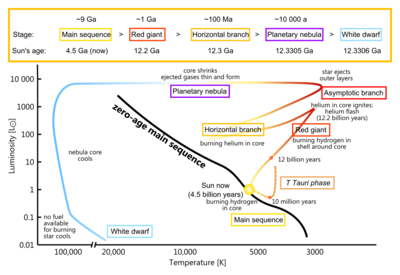
The Sun is now in its main-sequence stage. During this time, it fuses hydrogen into helium in its core. Every second, over 4 billion kilograms of matter turn into energy inside the Sun. This process creates neutrinos and solar radiation. So far, the Sun has turned about 0.03% of its total mass into energy.
The Sun will spend about 10 to 11 billion years as a main-sequence star. It is slowly getting hotter and brighter. Since it began its main-sequence life, its radius has grown by 15%. Its surface temperature has also increased. This has made it 48% brighter than it was at the start. This happens because the helium in the core is heavier than hydrogen. This causes the core to shrink slightly, which makes fusion happen faster. The Sun's brightness increases by about 1% every 100 million years.
What Happens After Hydrogen Runs Out?
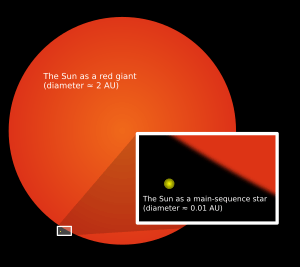
The Sun is not massive enough to explode as a supernova. Instead, in about 5 billion years, it will run out of hydrogen in its core. When this happens, the core will contract, and the Sun will expand. It will first become a subgiant, then a red giant.
As a red giant, the Sun will grow to be about 256 times larger than it is today. It will likely swallow Mercury and Venus. Earth's orbit will expand a bit, but eventually, Earth will also be engulfed by the Sun. The Sun will spend about a billion years in this red giant phase and lose about a third of its mass.
After the red giant phase, the Sun will have about 120 million years of active life left. The helium in its core will ignite in a "helium flash." The Sun will then shrink to about 10 times its current size. It will be 50 times brighter, but a little cooler.
When the helium runs out, the Sun will expand again. This time, it will happen faster. The Sun will become even larger and brighter. This is called the asymptotic giant branch phase. The Sun will become unstable, losing mass rapidly. It will also have "thermal pulses," where its size and brightness increase greatly for a few hundred years.
Finally, the Sun will shed its outer layers. This will form a beautiful glowing cloud of gas called a planetary nebula. The remaining core will become a white dwarf. This white dwarf will be very hot, over 100,000 K. It will contain about 54% of the Sun's original mass. The planetary nebula will disappear in about 10,000 years. The white dwarf will slowly cool down for trillions of years. Eventually, it will become a hypothetical super-dense black dwarf, giving off no more energy.
Where is the Sun Located?
In Our Solar System
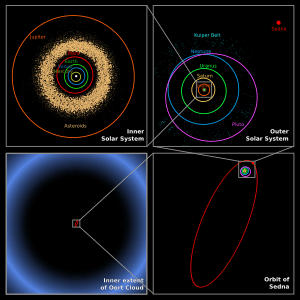
The Sun is at the center of our Solar System. Eight known planets orbit it: Mercury, Venus, Earth, Mars, Jupiter, Saturn, Uranus, and Neptune. Our Solar System also has dwarf planets, an asteroid belt, many comets, and icy bodies beyond Neptune. Six of the planets and many smaller bodies have their own moons.
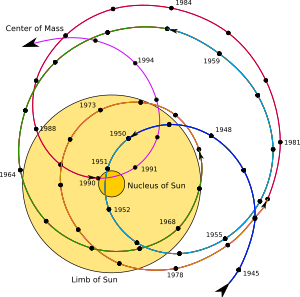
The Sun itself moves slightly. This movement is caused by the gravitational pull of the planets, especially Jupiter, Saturn, Uranus, and Neptune. The Sun moves around the Solar System's center of mass, which is called the barycentre. This motion repeats roughly every 179 years.
The Sun's gravity is so strong that it controls objects out to about two light-years away. This is much farther than the orbit of Neptune. The farthest known objects, like some comets, can be as far as 70,000 AU from the Sun.
How the Sun Moves in the Galaxy
The Sun, along with our entire Solar System, orbits the center of the Milky Way galaxy. It travels at an average speed of 230 kilometers per second (828,000 km/h). It takes about 220 to 250 million Earth years to complete one full orbit. This is called a galactic year. The Sun has completed about 20 orbits since it formed.
As the Sun orbits the galaxy, it also moves up and down through the galactic plane. It moves about 99 parsecs (about 323 light-years) away from the plane. The Sun's orbit around the Milky Way is not perfectly smooth. It is affected by the uneven distribution of mass in the galaxy, like the spiral arms. Some scientists think that when the Sun passes through denser spiral arms, it might cause more mass extinctions on Earth.
The Milky Way galaxy itself is also moving. It is moving at about 550 kilometers per second relative to the cosmic microwave background radiation. The Sun's speed relative to this background is about 370 kilometers per second.
How We Understand the Sun
Early Ideas About the Sun
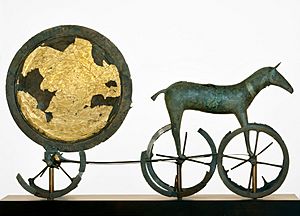
In ancient times, many cultures believed the Sun was a god or a powerful spirit. For example, the ancient Egyptians worshipped the Sun god Ra. The Incas and Aztecs also had sun worship as a central part of their beliefs. In Hinduism, the Sun is still seen as a god named Surya. Many ancient buildings were built to align with the Sun's movements, like Stonehenge in England.
The ancient Greeks were among the first to offer scientific ideas about the Sun. The philosopher Anaxagoras thought the Sun was a giant flaming ball of metal. He also correctly suggested that the Moon reflects the Sun's light. Later, Aristarchus of Samos proposed that the Earth and planets orbit the Sun. This idea, called Heliocentrism, was later developed by Nicolaus Copernicus in the 16th century.
Developing Scientific Knowledge
Chinese astronomers recorded observations of sunspots as early as the Han dynasty (202 BC–AD 220). The invention of the telescope in the early 17th century allowed scientists like Galileo Galilei to study sunspots in detail. Galileo realized that sunspots were on the Sun's surface.
In 1684, Giovanni Domenico Cassini made the first fairly accurate measurement of the distance to the Sun. He did this by measuring the distance to Mars when it was closest to Earth. Then, using Kepler's laws, he calculated the Earth-Sun distance. His measurement was much more accurate than previous ones.
In 1666, Isaac Newton used a prism to show that sunlight is made up of many colors. In 1800, William Herschel discovered infrared radiation coming from the Sun. The 19th century brought advances in studying the Sun's spectrum. Scientists found dark lines in the Sun's light, called Fraunhofer lines, which helped them understand what the Sun is made of.
In 1868, Norman Lockyer noticed some lines in the Sun's spectrum that didn't match any known elements on Earth. He guessed it was a new element and named it helium, after the Greek Sun god Helios. Twenty-five years later, helium was found on Earth.
For a long time, scientists wondered how the Sun produced so much energy. In 1904, Ernest Rutherford suggested that radioactive decay might be the source. But it was Albert Einstein's famous equation, E = mc2, that provided the key. In 1920, Arthur Eddington proposed that nuclear fusion in the Sun's core, where hydrogen turns into helium, was the source of its energy. This idea was later developed by Hans Bethe and others.
Space Missions to Study the Sun
The first satellites to study the Sun from space were the Pioneer 6, 7, 8, and 9 probes, launched by NASA between 1959 and 1968. They made the first detailed measurements of the solar wind and the Sun's magnetic field.
In the 1970s, the Helios spacecraft and the Skylab Apollo Telescope Mount gave scientists new information about the solar wind and corona. Skylab, launched in 1973, made the first observations of coronal mass ejections and coronal holes.
NASA launched the Solar Maximum Mission in 1980 to observe solar flares. After a repair by the Space Shuttle Challenger in 1984, it sent back thousands of images of the solar corona. Japan's Yohkoh satellite, launched in 1991, observed solar flares in X-rays.
The Solar and Heliospheric Observatory (SOHO), a joint project by the European Space Agency and NASA, was launched in 1995. SOHO is located at a special point between Earth and the Sun, giving it a constant view of the Sun. It has helped discover many comets.
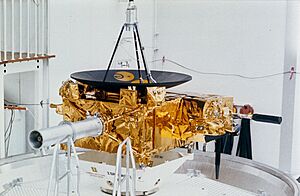
Most satellites observe the Sun from Earth's orbital plane. But the Ulysses probe, launched in 1990, studied the Sun's polar regions. It found that the solar wind from the poles was slower than expected.
The Genesis mission was designed to collect samples of the solar wind. This allowed scientists to directly measure the Sun's composition.
Looking at the Sun
How to Safely View the Sun
Looking directly at the Sun can be painful because it's so bright. Brief glances with the naked eye are usually not harmful for healthy eyes. However, staring at the Sun for more than about 100 seconds can damage your retina, especially if the UV light is strong.
Never look at the Sun through binoculars or a telescope without a special filter. These devices focus sunlight and can cause permanent eye damage very quickly. Always use filters designed specifically for solar viewing. Some homemade filters might block visible light but let harmful UV or infrared rays through.
During sunrise and sunset, the Sun's light is scattered by Earth's atmosphere. This makes the Sun appear dimmer and sometimes allows for safe viewing with the naked eye. Hazy conditions or dust in the air can also dim the Sun.
Special Sun Phenomena
Sometimes, you can see a green flash just after sunset or before sunrise. This happens when light from the Sun, just below the horizon, is bent by Earth's atmosphere. Shorter wavelengths of light (like green and blue) are bent more. Blue light is scattered away, leaving the green light visible for a brief moment.
The Sun in Culture and Beliefs
The Sun has been very important in many religions and myths around the world. Ancient civilizations like the Egyptians, Incas, and Aztecs worshipped the Sun. In some religions today, like Hinduism, the Sun is still seen as a god.
Many ancient monuments were built to honor the Sun. For example, Stonehenge in England and Newgrange in Ireland align with the Sun during the solstices. The pyramid of El Castillo in Mexico creates serpent-shaped shadows during the equinoxes.
The ancient Sumerians believed the Sun was Utu, the god of justice. The Romans celebrated the Sun's birthday as Sol Invictus (Unconquered Sun) near the winter solstice. The naming of the days of the week after planets, like Sunday for the Sun, comes from the Roman era.
In ancient Greek religion, the Sun god was Helios. Later, he was often linked with Apollo. In Japanese Shinto religion, the sun goddess Amaterasu is the most important deity. She is believed to be the ancestor of all Japanese emperors.
Images for kids
-
During a total solar eclipse the solar corona can be seen with the naked eye.
-
Depiction of the heliosphere
-
Evolution of a Sun-like star. The track of a one solar mass star on the Hertzsprung–Russell diagram is shown from the main sequence to the white dwarf stage.
-
The size of the current Sun (now in the main sequence) compared to its estimated size during its red-giant phase in the future
-
Location of the Sun within the Solar System, which extends to the edge of the Oort cloud, where at 125,000 AU to 230,000 AU, equal to several light-years, the Sun's gravitational sphere of influence ends.
-
Apparent motion of the Solar System barycentre with respect to the Sun
-
The Trundholm sun chariot pulled by a horse is a sculpture believed to be illustrating an important part of Nordic Bronze Age mythology.
-
Ulysses spacecraft testing at the vacuum spin-balancing facility
See also
 In Spanish: Sol para niños
In Spanish: Sol para niños


